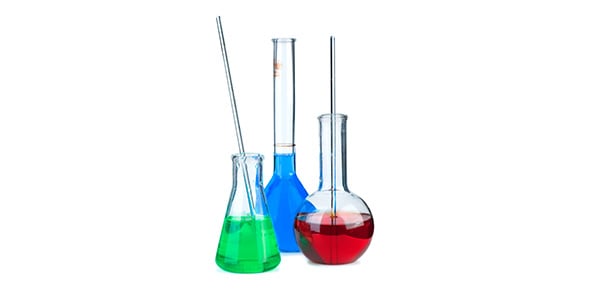Chemical Reactions Pre-assessment

- 1.
Chemical reactions
- A.
Occur only in living organisms.
- B.
Create and destroy atoms.
- C.
Only occur outside living organisms.
- D.
Produce new substances.
Correct Answer
D. Produce new substances. -
- 2.
A net ionic equation
- A.
Shows the spectator ions.
- B.
Shows only those particles involved in the reaction.
- C.
Is not necessarily balanced with respect to mass or charge.
- D.
Shows dissolved ionic compounds as dissociated free ions.
Correct Answer
B. Shows only those particles involved in the reaction. -
- 3.
What does the triangle symbol above the arrow in a chemical equation mean?
- A.
Heat is supplied to the reaction.
- B.
A catalyst is needed in the reaction.
- C.
Electricity is need in the reaction.
- D.
A precipitate will form during the reaction.
Correct Answer
A. Heat is supplied to the reaction. -
- 4.
Which of the following combinations of symbol and explanation of symbol is correct when used in a chemical equation?
- A.
(g), grams
- B.
(l), liters
- C.
(aq), dissolved in water
- D.
(s), solid product
Correct Answer
C. (aq), dissolved in water -
- 5.
In the chemical equation H<sub>2</sub>O<sub>2</sub> à H<sub>2</sub>O + O<sub>2</sub>f the O<sub>2</sub> is a ____.
- A.
Catalyst
- B.
Solid
- C.
Product
- D.
Reactant
Correct Answer
C. Product -
- 6.
Which of the following is the correct skeleton equation for the reaction that takes place when solid phosphorus combines with oxygen gas to form diphosphorus pentoxide?
- A.
P (s) + O2(g) -->P O2 (g)
- B.
P(s) + O2(g) --> P5 O2 (g)
- C.
P(s) + O2(g) -->P2 O5 (s)
- D.
P2 O5 (s) --> P2 (s) + O2 (g)
Correct Answer
C. P(s) + O2(g) -->P2 O5 (s) -
- 7.
When the equation Fe + Cl2 à FeCl3 is balanced, what is the coefficient for Cl ?
- A.
1
- B.
2
- C.
3
- D.
4
Correct Answer
C. 3 -
- 8.
When the following equation is balanced, what is the coefficient for HCl? Mg(s) + HCl (aq) à MgCl2 (aq) + H2 (g)
- A.
6
- B.
3
- C.
1
- D.
2
Correct Answer
D. 2 -
- 9.
Which of the following statements is true about what happens in all chemical reactions?
- A.
The ways in which atoms are joined together is not changed.
- B.
New atoms are formed as products.
- C.
The final substances are called reactants.
- D.
Bonds between atoms are broken and new bonds are formed.
Correct Answer
D. Bonds between atoms are broken and new bonds are formed. -
- 10.
When the equation KClO3 (s) à KCl (s) + O2 (g) is balanced, the coefficient of KClO3 is
- A.
1
- B.
2
- C.
3
- D.
4
Correct Answer
B. 2 -
- 11.
In a combustion reaction, one of the reactants is
- A.
Hydrogen
- B.
Nitrogen
- C.
Oxygen
- D.
Metal
Correct Answer
C. Oxygen -
- 12.
The reaction 2Fe + 3Cl2 --> 2FeCl3 is an example of which type of reaction?
- A.
Combustion reaction
- B.
Single-replacement reaction
- C.
Combination reaction
- D.
Decomposition reaction
Correct Answer
C. Combination reaction -
- 13.
The equation Mg(s) + 2HCl(aq) --> MgCl2(aq) + H2(g) is an example of which type of reaction?
- A.
Combination reaction
- B.
Single-replacement reaction
- C.
Decomposition reaction
- D.
Double-replacement reaction
Correct Answer
B. Single-replacement reaction -
- 14.
The equation H3PO4 + 3KOH --> K3PO3 + 3H2O is an example of which type of reaction?
- A.
Double-replacement reaction
- B.
Combination reaction
- C.
Decomposition reaction
- D.
Single-replacement reaction
Correct Answer
A. Double-replacement reaction -
Quiz Review Timeline +
Our quizzes are rigorously reviewed, monitored and continuously updated by our expert board to maintain accuracy, relevance, and timeliness.
-
Current Version
-
Mar 09, 2013Quiz Edited by
ProProfs Editorial Team -
Feb 21, 2013Quiz Created by
Jkrug
- Aeronautics Quizzes
- Aerospace Quizzes
- Agricultural Science Quizzes
- Astrology Quizzes
- Astronomy Quizzes
- Atom Quizzes
- Biochemistry Quizzes
- Biology Quizzes
- Biomechanics Quizzes
- Biostatistics Quizzes
- Biotechnology Quizzes
- Botany Quizzes
- Branches Of Science Quizzes
- Cytology Quizzes
- Easy Science Quizzes
- Ecology Quizzes
- Electrical Quizzes
- Embryology Quizzes
- Endocrinology Quizzes
- Engineering Quizzes
- Environmental Science Quizzes
- Epidemiology Quizzes
- Experiment Quizzes
- Forestry Quizzes
- Fossil Quizzes
- Gas Quizzes
- General Science Quizzes
- Genetics Quizzes
- Histology Quizzes
- Human Biology Quizzes
- Integrated Science Quizzes
- Invention Quizzes
- Library Science Quizzes
- Lighting Quizzes
- Liquid Quizzes
- Marine Biology Quizzes
- Microbiology Quizzes
- Molecular Biology Quizzes
- Nature Quizzes
- Neuroscience Quizzes
- Nuclear Science Quizzes
- Oceanography Quizzes
- Physics Quizzes
- Psychology Quizzes
- Science And Technology Quizzes
- Science Glossary Quizzes
- Science Knowledge Quizzes
- Science Practice Quizzes
- Scientific Method Quizzes
- Scientific Notation Quizzes
- Soil Science Quizzes
- Solar System Quizzes
- Solid Quizzes
- Zoology Quizzes
 Back to top
Back to top


